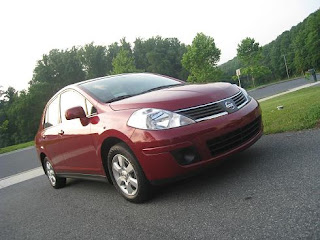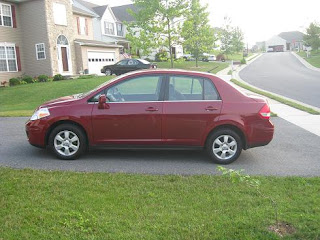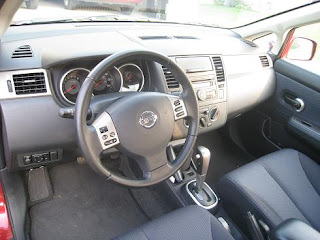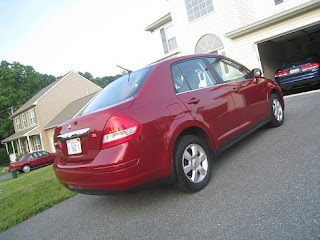2008 Nissan Versa 1.8 SL Sedan Review
 A few years ago, the major Japanese manufacturers hit the US market nearly simultaneously with new small car offerings that offered smaller engines, better fuel economy, and often better packaging than offerings that had previously been their smallest US offerings. The models I’m speaking of are the Toyota Yaris (which replaced the unloved Echo), the Honda Fit, and the Nissan Versa.
A few years ago, the major Japanese manufacturers hit the US market nearly simultaneously with new small car offerings that offered smaller engines, better fuel economy, and often better packaging than offerings that had previously been their smallest US offerings. The models I’m speaking of are the Toyota Yaris (which replaced the unloved Echo), the Honda Fit, and the Nissan Versa.
Nissan took a slightly different track when it developed the Versa than did its closest competitors. First, the styling is unique, which is not a surprise considering that a version of the car’s platform underpins some Renaults. Second, the Versa has a larger, more powerful engine (a 1.8 liter four cylinder) than either the Fit or Yaris (both having 1.5 liter four cylinders). The Fit and Yaris also have conventional automatic transmissions while the Versa has a CVT.
 Walking up to the Versa, the car has a unique shape, but it’s definitely not my cup of tea from a styling standpoint. The proportions are the first thing you notice; unlike the current trend of low rooflines and minimally tall windows, the Versa practically boasts of its height to anyone who will listen. Certain lines in the car’s profile take sudden zig-zag turns, such as the shape of the taillights and front side markers. The roofline also slowly heads downhill starting above the B-pillar, then makes a sharp turn at the C-pillar. One area in which the Versa did match current fashion is its tidy overhangs; there is only a minimal piece of the front end that dangles over the wheel wells, and considering the car’s front wheel drive layout, it’s again fairly tidy. The other notable styling cues are a trunklid shape reminiscent of a BMW’s “Bangle butt”, with a hood closure that shares a complementary design. My test vehicle was shod with 15 inch alloy wheels, which actually looked more like 16 inch wheels would on a normally-sized car. The Versa didn’t hide the fact that the wheels were affixed with just four lugs, but many small cars also have only four lug wheels. Heck, the Honda Accord only had four lug wheels earlier in this decade.
Walking up to the Versa, the car has a unique shape, but it’s definitely not my cup of tea from a styling standpoint. The proportions are the first thing you notice; unlike the current trend of low rooflines and minimally tall windows, the Versa practically boasts of its height to anyone who will listen. Certain lines in the car’s profile take sudden zig-zag turns, such as the shape of the taillights and front side markers. The roofline also slowly heads downhill starting above the B-pillar, then makes a sharp turn at the C-pillar. One area in which the Versa did match current fashion is its tidy overhangs; there is only a minimal piece of the front end that dangles over the wheel wells, and considering the car’s front wheel drive layout, it’s again fairly tidy. The other notable styling cues are a trunklid shape reminiscent of a BMW’s “Bangle butt”, with a hood closure that shares a complementary design. My test vehicle was shod with 15 inch alloy wheels, which actually looked more like 16 inch wheels would on a normally-sized car. The Versa didn’t hide the fact that the wheels were affixed with just four lugs, but many small cars also have only four lug wheels. Heck, the Honda Accord only had four lug wheels earlier in this decade.
 Inside, the Versa shines. As Honda engineers managed with the Fit subcompact, the interior seems to be larger and more flexible than it should be for such a small vehicle. Credit goes to the tall roofline, large window surface area, and wheels pushed to the corners of the car. The result is a car with enough room for me to “sit behind myself” at 6’4″ (when the driver’s seat is adjusted to a spot comfortable for me). I had plenty of headroom; I was able to make a fist and fit that between the top of my head and the ceiling with room to spare. Width-wise, the car was a little narrow – in fact, narrower than, say, a Prius, but other than in width measurements, actually was similar to the Prius in categories like legroom and headroom (and the Prius is classified as a midsize car). Actually, the Versa is also classified as a midsize car by the EPA. Compared to the Nissan Sentra, the Versa has more rear seat headroom and legroom, more cargo space, but less shoulder and hip room because the Versa is about four inches narrower than the Sentra.
Inside, the Versa shines. As Honda engineers managed with the Fit subcompact, the interior seems to be larger and more flexible than it should be for such a small vehicle. Credit goes to the tall roofline, large window surface area, and wheels pushed to the corners of the car. The result is a car with enough room for me to “sit behind myself” at 6’4″ (when the driver’s seat is adjusted to a spot comfortable for me). I had plenty of headroom; I was able to make a fist and fit that between the top of my head and the ceiling with room to spare. Width-wise, the car was a little narrow – in fact, narrower than, say, a Prius, but other than in width measurements, actually was similar to the Prius in categories like legroom and headroom (and the Prius is classified as a midsize car). Actually, the Versa is also classified as a midsize car by the EPA. Compared to the Nissan Sentra, the Versa has more rear seat headroom and legroom, more cargo space, but less shoulder and hip room because the Versa is about four inches narrower than the Sentra.
The seats were made of a fairly coarse cloth; I didn’t mind it, but it really bothered my wife. The door panels were covered in the same material, with padded vinyl at the top and a very thickly padded armrest. The armrests literally had a half inch of give when pressed with a finger and were very cushy. Aside from a nicely-woven headliner, the rest of the interior was fairly reminiscent of what you’d expect to find in an economy car: hard plastic on the dashboard, low-gloss black plastic around the HVAC controls and radio, and fairly thin sound insulation from road noise and the engine. Interior features, however, in the SL model that I tested were impressive for a car in this class. My test vehicle featured keyless entry and ignition, voice-activated Bluetooth cell phone integration, cruise control, power windows, locks, and mirrors, and a six-disc CD changer with an auxiliary in jack on the front. Since I have a steering wheel fixation (I prefer them to be small in circumference but with a thick rim, and always covered in leather), the Versa didn’t disappoint. The wheel nailed two out of my three criteria, lacking only a thick rim. Cruise control and redundant audio and phone controls were on the spokes, which was nice to have in an inexpensive car.
HVAC controls were, of course, manual, and I had nearly forgotten how annoying it is to have to decide on a mode, temperature setting, and fan speed periodically while driving (rather than just setting a temperature and forgetting about it). You don’t get automatic climate control for $17,290, though.
The economy-grade sound insulation made for a ride that was somewhat noisy upon acceleration. Wind noise wasn’t readily apparent, but driving through a city, it was a little too easy to hear external sounds even with the windows closed. If you haven’t driven a vehicle equipped with a CVT before, the CVT is nearly invisible when you are accelerating slowly or moving at a fairly constant speed. However, brisk acceleration causes the transmission to peg the engine in the thick of its powerband (about 5,500 RPMs in the Versa’s case) and keep it there until the desired speed is reached. The transmission, of course, is continually varying its ratio while the engine speed remains constant. The resulting sensation is one of a conventional automatic that is slipping. It’s also an assault on the ears, as the 1.8 liter four is not the quietest engine in the world, and there is no rest from its booming until the desired speed has been reached. (In a conventional transmission, even under the hardest acceleration, gear changes quiet the engine’s clatter momentarily as it spins slower). CVTs, however, do have both a fuel economy and a performance benefit, and Nissan has a reputation for doing a better job with them than anyone else. The Versa does not have the slick manual/sport mode that some other Nissan CVTs feature, which allows the driver to impersonate a conventional automatic transmission, with six forward ratios pre-programmed into the CVT for use upon demand. Interestingly, Nissan’s website only allows you to configure a 2009 Versa (my test vehicle was a 2008) with a CVT if choosing the SL hatchback. Otherwise, transmission choices are a six-speed manual or a four-speed automatic.
The brakes were front disc/rear drum, which is a cheaper alternative than would be found in more expensive vehicles. My test vehicle included optional ABS (only $250, and of course worth the money), which I did not have occasion to try, but the brakes were a bit grabby until I got used to them. The steering was electric power assisted, but was the second-best electric power steering I’ve ever tested (the best being the $40,000-plus Lexus IS350’s). It still can’t quite match traditional hydraulic steering for feedback and feel, but it was close enough that I had to check the window sticker to verify my guess that it might be electric.
The car never felt unsafe on the highway (nor did I feel vulnerable driving a small car), but I also was cognizant of the fact that I was driving a narrow, small car with 15 inch wheels and a relatively high center of gravity. It certainly did not embarrass itself on the road, though, and was a fairly comfortable commuter car.
In terms of fuel economy, the Versa is rated at 27 miles per gallon in the city and 33 miles per gallon on the highway. Unfortunately, the Versa does not have a trip computer that will show fuel economy averages, and I did not need to add gas to the full tank that Nissan provided, so I’ll have to assume that it got somewhere between the EPA’s city and highway figures. After about 200 miles, the gas gauge is below the halfway point, but the Versa only has a 13.2 gallon tank. Relative to its closest competitors, the Versa’s economy is fairly close when comparing automatic-equipped models with the base engines. The Fit is rated at 27/34, the Yaris is rated at 29/35, the Civic is rated at 25/36, and the Corolla is rated at 27/35.
 The 2008 Versa starts at $13,540 for a Versa S, which is available as a sedan or hatch for the same price, and includes air conditioning, AM/FM/CD stereo, side curtain and side impact airbags, and power steering. Stepping up to the Versa SL (which is what my test vehicle was) costs $16,175 and adds 15 inch aluminum wheels, power windows and locks, remote keyless entry, cruise control, and an upgraded stereo with a CD changer. My tester also featured the Convenience Package for $650, which added Bluetooth, the leather wrapped steering wheel, and keyless entry/start (which allows you to keep the key in your pocket, even when starting the car), the aforementioned $250 ABS package, splash guards for $110, and floor mats for $105. The destination charge was $625, for a grand total of $17,290. I thought that was a pretty fair price for a capable little car. Compared to the 2009 Corolla that I tested a few weeks ago, the Versa had power windows, cruise control, Bluetooth, keyless entry/start, and aluminum wheels – none of which the Corolla S had – but had an MSRP about $1,200 less. I also preferred the Nissan’s steering feel to the Corolla’s, although the Corolla S is a much better looking car than the Versa (though the Versa hatchback is a much more pleasing shape to my eyes than the somewhat frumpy sedan is).
The 2008 Versa starts at $13,540 for a Versa S, which is available as a sedan or hatch for the same price, and includes air conditioning, AM/FM/CD stereo, side curtain and side impact airbags, and power steering. Stepping up to the Versa SL (which is what my test vehicle was) costs $16,175 and adds 15 inch aluminum wheels, power windows and locks, remote keyless entry, cruise control, and an upgraded stereo with a CD changer. My tester also featured the Convenience Package for $650, which added Bluetooth, the leather wrapped steering wheel, and keyless entry/start (which allows you to keep the key in your pocket, even when starting the car), the aforementioned $250 ABS package, splash guards for $110, and floor mats for $105. The destination charge was $625, for a grand total of $17,290. I thought that was a pretty fair price for a capable little car. Compared to the 2009 Corolla that I tested a few weeks ago, the Versa had power windows, cruise control, Bluetooth, keyless entry/start, and aluminum wheels – none of which the Corolla S had – but had an MSRP about $1,200 less. I also preferred the Nissan’s steering feel to the Corolla’s, although the Corolla S is a much better looking car than the Versa (though the Versa hatchback is a much more pleasing shape to my eyes than the somewhat frumpy sedan is).
However, like minivans, people don’t buy compact or subcompact cars for image reasons. In this case, the Versa provides a very credible entry at the lower end of the market, including some features not available in more expensive vehicles at any price (keyless start and Bluetooth, specifically). Nissan did a heck of a job with the Versa and is offering a car that is more comfortable and more spacious than expected. Any time consumers get more than they expect for their money, they win.




